- Top 10 DevOps Tools for Continuous Integration
- Top 10 Devops Tools
- Repository Management Tools
- 10 Tools For Effective DevOps Collaboration
- Top 12 Open Source DevOps Build Tools
- Configuration Management Tools in DevOps
- Agile Vs DevOps
- Chef DevOps Interview Questions
- What is Continuous Integration in DevOps?
- Insights of DevOps Architect
- DevOps Automation: How is it Carried Out?
- Introduction To DevOps Docker
- DevOps For Dummies
- DevOps Interview Questions
- 13 DevOps Testing Tools For DevOps Professionals
- Best DevOps Tools and Frameworks to explore
- DevOps Tutorial For Beginners: A Step-by-Step Guide To Learn DevOps
- Cacti Graphing And Monitoring
- RANCID Tool Keeps Config Files Clean
- How To Enable LLDP on Linux Servers for Link Discovery
- How to set up a modern web stack in Ubuntu
- Useful Iperf Commands for Network Troubleshooting
- Migration of MongoDB to DynamoDB
- MongoDB and Tree Structures
- Multihost SSH Wrapper
- DevOps Tools for Infrastructure Automation
- Introduction To Azure DevOps
- Introduction To DevOps Tools
- List of DevOps Monitoring Tools
- The Ultimate List of DevOps Deployment Tools
- Top 10 Open Source Containerization DevOps Tools
- Reasons for the Rise of DevOps
- Role Of a DevOps Engineer
- DevOps Security Tools
- Some Common Myths about DevOps
- Top 10 Devops tools in cloud
- Release Management Tools
- Top 10 SCM Tools
- Logging DevOps Tools
- DevOps And Its Significance
- DevSecOps Interview Questions
- Ansible vs Chef
- DevSecOps Tutorial
- What is Site Reliability Engineering - SRE Tools
- Site Reliability Engineer(SRE) Interview Questions
- DevOps Vs SysOps
- DevOps Engineer Job Description
- Azure DevOps Jira Integration
- What is Pipeline in DevOps?
- SonarQube Azure DevOps
- Azure DevOps CI/CD
Managing the Data that is growing faster and faster is a huge challenge for every business today. For business teams to make strategic decisions, they need data in real time so they can gain insights. In this fast-paced world, needs change quickly, which often slows things down.
To fix this, Businesses are now using the DataOps method to build an ecosystem where IT and business teams can work together better. In this article, you'll learn about the DataOps method, which is used by companies all over the world.
What is DataOps?
Almost everyone thinks this when they hear the word "DataOps" for the first time. Even though the name "DataOps" is a little confusing in terms of meaning, it does show that data analytics can do what "DevOps" did for software development.
DataOps is an Agile way to design, build, and maintain a distributed data architecture that will work with a wide range of open-source tools.
That is to say, DataOps can improve quality and cycle time by an order of magnitude when data teams use new tools and methods. DataOps also speeds up the development of software (like new analytics), but it also has to manage a dynamic manufacturing operation (i.e., data operations). DevOps improve the software development pipeline. It is what makes it possible for companies like Amazon, Netflix, and Google to release millions of lines of code every year.
DataOps is a set of Technical Best Practices, processes, social customs, and architectural designs that make it possible to use:
- Increasingly quick invention and experimentation offer fresh insights to customers
- extremely reduced error rates and very high data quality
- Collaboration between diverse groups of individuals, technologies, and settings
- Clear results transparency, monitoring, and measuring
DataOps includes DevOps and other methods that can be used to handle the unique problems that come up when managing a business-critical data operations pipeline.
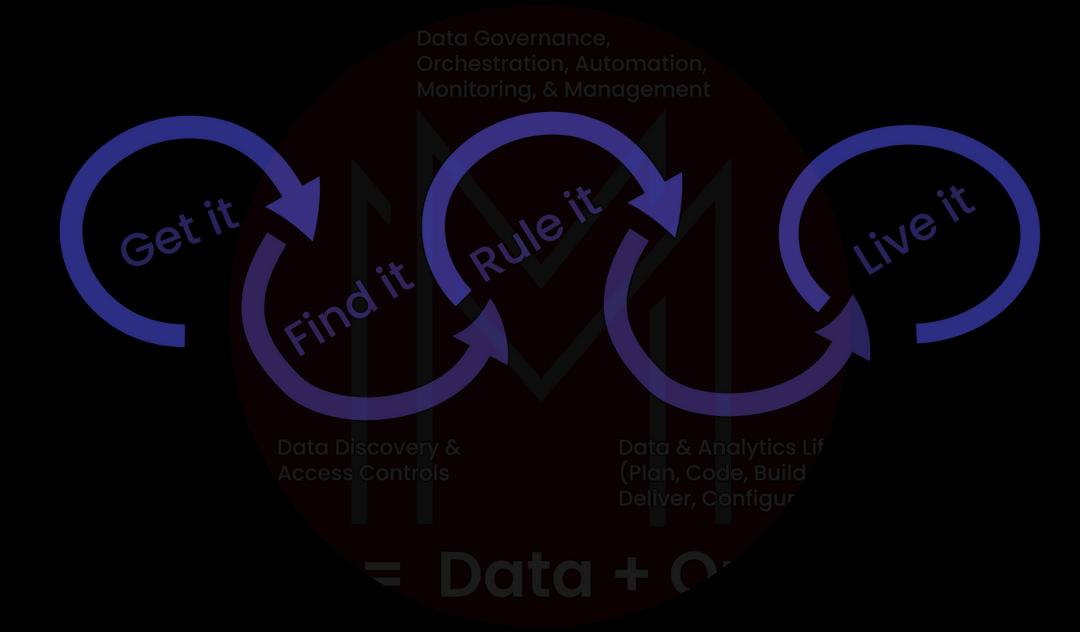
| If you want to enrich your career and become a professional in DataOps, then enroll in "DevOps Online Training" - This course will help you to achieve excellence in this domain. |
Why is DataOps Important?
DataOps in business is very important right now because the world of technology deals with data all the time.
- It makes it possible to have very good data quality and very few mistakes.
- It helps people work together throughout the whole life cycle of an organization's data.
- It makes it easy to try out new ideas and experiment quickly.
- It helps make sure that data is open and safe at the same time.
- DataOps makes processes easier and makes sure that insights are always delivered.

DataOps Intellectual Heritage
We can trace the development of DataOps back to the ground-breaking work of management expert W. Edwards Deming, who is frequently credited with sparking the Japanese economic miracle after World War II.
In the current era of Software Development and IT, the manufacturing approaches riding Deming's coattails are being widely adopted. These approaches are further introduced into the dataframe by DataOps. In a word, DataOps applies lean manufacturing, agile development, and DevOps to the development and operation of data analytics.
Agile is a software development methodology that applies the Theory of Constraints. Smaller lot sizes reduce work-in-progress and boost total manufacturing system throughput. Applying lean concepts to application creation and delivery (e.g., eliminating waste, continual improvement, broad focus) naturally leads to DevOps.
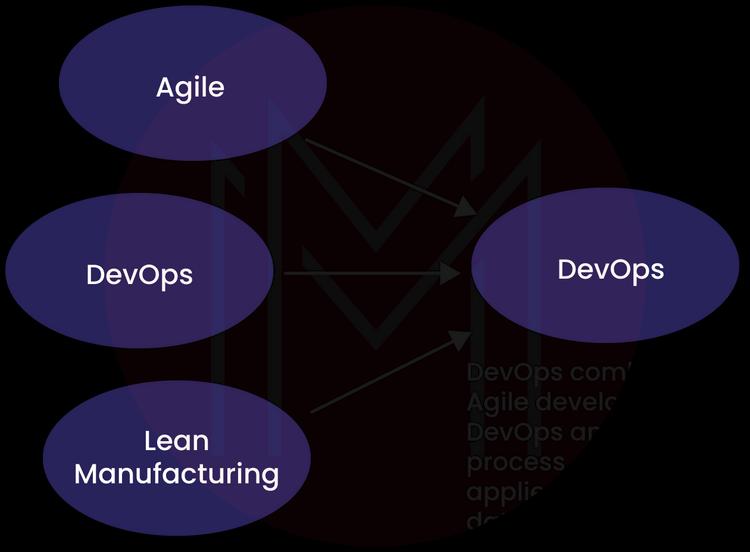
Driver and Objective of DataOps
Both DevOps and DataOps use ideas from lean manufacturing in numerous ways. The goals for all three are increased output, higher output quality, and complete predictability and reliability.
Data teams are under a lot of strain as a result of the dramatically higher complicated data environments and data flows. Although business and analytical teams are still waiting for new data needed for the analytics and frequently lack faith in the information they do receive, project backlogs have increased. A research study discovered a major lack of confidence in data and the fact that a lot of company data is wasted.
What is the Working Process of DataOps?
The goal of DataOps is to bring together DevOps and Agile methods to manage data in a way that supports business goals. Agile processes are used for data governance and analytic development, while DevOps processes are used to optimize code, product builds, and delivery.
DataOps based its work on the following principles to create a more flexible and effective data management plan
- Agile Methodology
- Lean Manufacturing
- DevOps
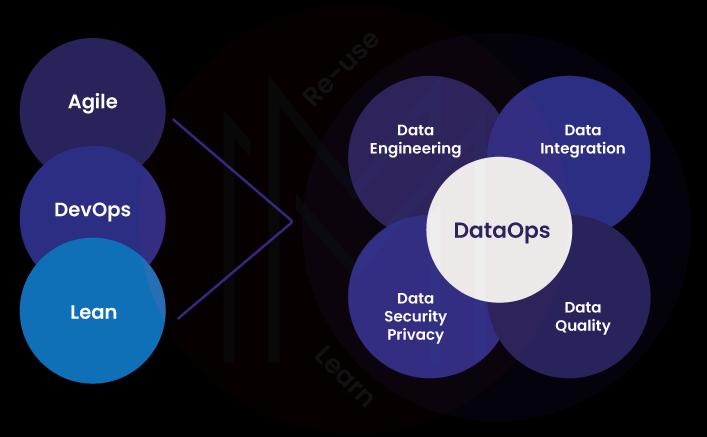
1. Agile Methodology
This method works best when requirements change quickly. You can also cut down on data search and model deployment time. This lets IT teams adapt to business teams fast. Since business teams now know what data teams do, transparency increases.
2. Lean Manufacturing
The Lean Manufacturing methodology reduces waste and increases productivity without sacrificing product quality. In addition to creating data pipelines, Data Engineers are frequently tasked with putting models into production and resolving pipeline problems. A large amount of time can be saved by employing lean manufacturing techniques.
3. DevOps
DevOps is a software development technique that utilizes DevOps automation to speed up the build life cycle. DevOps emphasizes continuous software delivery by leveraging IT resources on demand and automating code integration, testing, and deployment. This convergence of software development ("dev") and IT operations ("ops") saves deployment time, minimizing errors and resolving problems.
Using the ideas of DevOps as inspiration, Data teams may cooperate more effectively and deliver faster. DataOps allows you to independently deploy models and conduct analyses without relying on the engineering or IT teams, hence increasing your independence.
| Related Article: DevOps Tutorial |
What is the Difference between DataOps and DevOps?
The scope is the main difference. DevOps, which came first, makes it easier for IT's development and operations teams to work together. It has one delivery pipeline, from writing the code to running it.
DataOps, on the other hand, builds and needs collaboration from the IT people, the data experts, and finally the people who use the data. DataOps has a number of pipelines that run data flow and train data models.
So, DevOps improves the efficiency of your IT department, while DataOps improves the efficiency of the whole organization.
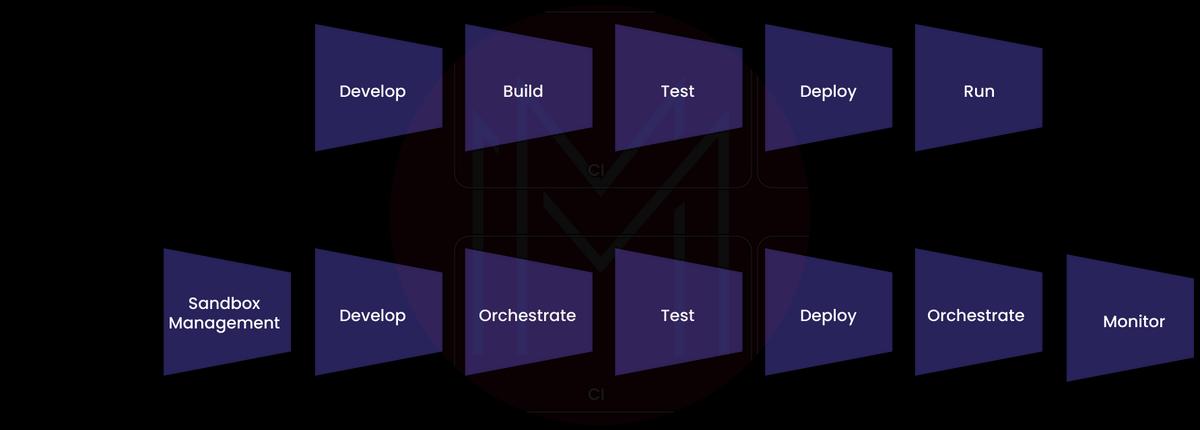
Benefits of DataOps
The Primary advantages of using DataOps will be emphasized in this section. As with DevOps, DataOps encourages:
- Distribution of software continuously
- Less complicated to control
- Faster problem resolution
- Happier and more effective groups
- More engaged employees
- Increased opportunities for professional development
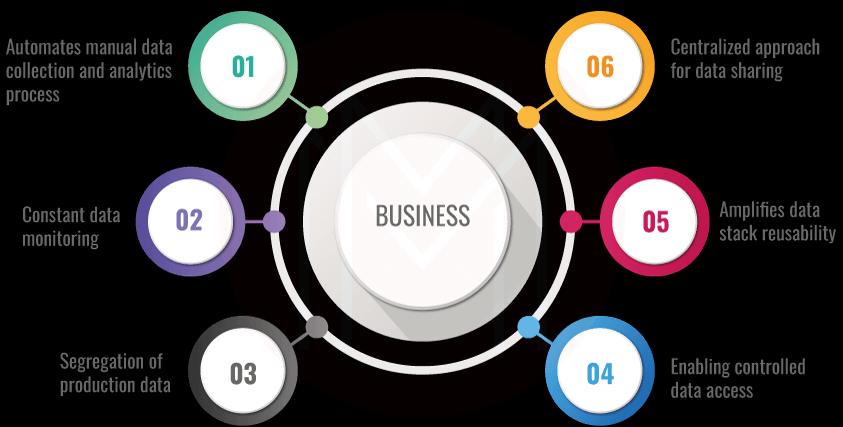
Features of DataOps
Data platforms must be able to support a number of crucial capabilities that help DataOps processes in order to deliver on the functional improvements promised by DataOps. The following features are arranged in 5 categories
1. Speed
- Reuse
- Collaboration
- UX for self-service
- simple product ionization
2. Output (with all of Speed's features)
- Adaptable modes of delivery and consumption
- engines for scalable execution
- performance improvement
- Scalable leadership
3. Quality
- Data quality functions aided by machine learning
- Data quality evaluation
- Usability of data
- accuracy of the data
- granular, end-to-end data lineage
4. Governance
- Comprehensive, detailed metadata
- Business-level security
- Granular, end-to-end data lineage
- Thorough auditing
5. Reliability
- Automated processes
- Data archiving and preservation
- Granular, end-to-end data lineage
- Data pipeline surveillance
- Small-scale logging
- Auditing changes
- Problem warnings
Relationship between Agile and Data Teams
Agile principles can be applied by data teams to work with massive data and promote speedy corporate decision-making.
Let's imagine that right now, it takes your data team two months to adapt to organizational changes. This ultimately slows down corporate operations and increases tension among your IT and possibly for a company. You may significantly cut down on the amount of time you spend looking for the appropriate data or putting data science algorithms into use by using DataOps. IT may therefore modify and react at the rate of business. The best thing is that your business teams no longer view the work your data team performs as a mystery.
What is Lean Manufacturing?
Pipelines connect the numerous manufacturing workstations where raw materials are turned into finished products. With lean manufacturing, there is less waste and more efficiency without compromising the quality of the final product.
Relationship between Lean Manufacturing and DataOps Teams
For the purpose of transforming data into useful reports or visualizations, data teams construct pipelines (think ETL/ELT).
Let's assume that your data engineers currently devote the majority of their time to creating pipelines, putting models (that our data scientists created) into production, and resolving pipeline-related problems. That period of time decreases dramatically using DataOps. To better manage your data, processes, and teams, DataOps employs the ideas of Agility, DevOps, and Lean Manufacturing. Everything looks wonderful on paper.
What problem is DataOps trying to Solve?
DataOps gives you full control over all of your organization's processes and operations. It also eliminates the things that slow down data management, making your team more productive. Because of this, you can launch new solutions, services, products, and more in a fraction of the time it would normally take.
DataOps solves many problems and challenges that data and marketing and sales teams often face.
Some of these difficulties are
- Fixing Bugs: DataOps is a very important part of managing incidents. Finding and fixing problems with products and services takes work from more than just the DevOps team. Instead, data experts are very important to the process, and communication between the two teams speeds up the process of fixing bugs by a lot.
- Goal Setting: DataOps provides developers and data scientists with information about how well data systems are functioning. With the use of a predefined set of business processes, the information gleaned from the teams may be used to ascertain and adjust the status of the company's operational objectives in real time.
- Slow response: Companies often need help keeping track of development requests, which causes the data and development teams to argue and make demands back and forth. On the other hand, DataOps could change that by making it easier for the dev and ops teams to talk to each other and work together when making and improving software apps and other products.
- Productivity: DataOps is also renowned for increasing a company's productivity and efficiency. In conventional development approaches, there are multiple tiers of performance reporting structures. With DataOps, however, both the development and data teams work in real-time, making it simpler for them to communicate information.
- Limited Collaboration: Collaborative effort between data administration and development is essential for effective operations, and this is what DataOps aims to provide. The two groups are now able to work together and share information effectively.
What is a DataOps Automation?
DataOps is a collaborative data management practice that improves data integration, communication, and automation.
To implement DataOps, businesses must use various methods and automation in addition to their current set of resources. While some companies opt to build their own internal DataOps infrastructure, the easiest way to enjoy the benefits of DataOps is by utilizing an existing DataOps platform. So, this DataOps automation facilitates analytics creation, deployment, and operation in a production setting.
The main aim of DataOps automation is to reduce the time it takes to get value from data over its whole life cycle. It includes analysis, planning, design, development, orchestration, testing, deployment, management, operations, change management, and documentation, all of which are important parts of the building and running of a data platform.
DataOps automation platform unifies the processes and procedures involved in data analytics's three stages of development and operation—planning, development, and execution. It integrates your current resources with robotic processes that propel analytics development and the refinement of raw data into insights. Because of this, teamwork is simplified.
The software for DataOps Automation has four main Features
- Automated deployment
- Fosters collaboration
- Spins up safe and synchronized workspaces
- Orchestrates, tests, and monitors the data pipeline
DataOps FAQs
1. What is DataOps Methodology?
The DataOps Methodology is made so that a company can build and deploy analytics and data pipelines using a repeatable process. They can give AI high-quality enterprise data by following the best data governance and model management practices.
2. Why do we need DataOps?
DataOps helps get around problems and make things easier so that analytics can be delivered quickly and easily without sacrificing the quality of the data. It is based on the ways that Lean Manufacturing, Agile, and DevOps work.
3. Who uses DataOps?
Data teams use DataOps platforms as consolidated command centers that facilitate the orchestration of multi-stage data pipelines.
4. What is the difference between MLOps and DataOps?
DataOps aims to speed up the time it takes to get products to market and improve the quality of the outputs. The main goal of MLOps is to make it easier to manage and deploy machine learning models. MLOps is meant to make it easier for ML models to be used in production environments.
5. What are DataOps Tools?
DataOps Tools are a new type of technology that helps organizations improve their productivity by integrating and automating processes and making it easier to get data to them.
6. What problems does DataOps solve?
The agile methodology of DataOps makes it possible for data professionals to deploy and change data pipelines quickly and in specific ways. This cuts down on manual and time-consuming processes. It makes the data team and business users more productive by getting rid of the need to wait for data to finish operations.
7. What are some of the Components of DataOps?
The Components of a DataOps Strategy are
- Infrastructure as code.
- Data modeling.
- Source control management.
- Monitoring and logging
- Continuous integration/delivery.
- Build/Deploy strategy.
- Workflow management.
- Data quality validation.
8. What are the three pipelines of DataOps?
Production, Development, and Environment are the three distinct types of DataOps pipelines.
9. What is the DataOps pipeline?
Many businesses use an Agile framework called a "DataOps pipeline" to better manage their data. It gives AI, machine learning, and analytics the structure they need to make the whole process of gathering, preparing, managing, and developing data easier.
10. What are the 4 key components of DevOps?
For a DevOps pipeline to work well, it should have the following basic components:
- Source control management.
- Code testing framework.
- Build automation tools.
- CI/CD framework.
| Related Article: DevOps Interview Questions |
Conclusion
DataOps is the process of coordinating people, processes, and technology to provide high-quality, trustworthy data to the appropriate individuals rapidly. Let's see if and how it gains popularity. In the meanwhile, a solid foundation in the more established area of DevOps is an excellent approach to getting started in the relatively new field of DataOps.
Check out our DevOps Training Course, provided by Mindmajix experts to advance your career today!
 On-Job Support Service
On-Job Support Service
Online Work Support for your on-job roles.

Our work-support plans provide precise options as per your project tasks. Whether you are a newbie or an experienced professional seeking assistance in completing project tasks, we are here with the following plans to meet your custom needs:
- Pay Per Hour
- Pay Per Week
- Monthly
| Name | Dates | |
|---|---|---|
| DevOps Training | Dec 20 to Jan 04 | View Details |
| DevOps Training | Dec 23 to Jan 07 | View Details |
| DevOps Training | Dec 27 to Jan 11 | View Details |
| DevOps Training | Dec 30 to Jan 14 | View Details |

Madhuri is a Senior Content Creator at MindMajix. She has written about a range of different topics on various technologies, which include, Splunk, Tensorflow, Selenium, and CEH. She spends most of her time researching on technology, and startups. Connect with her via LinkedIn and Twitter .
















